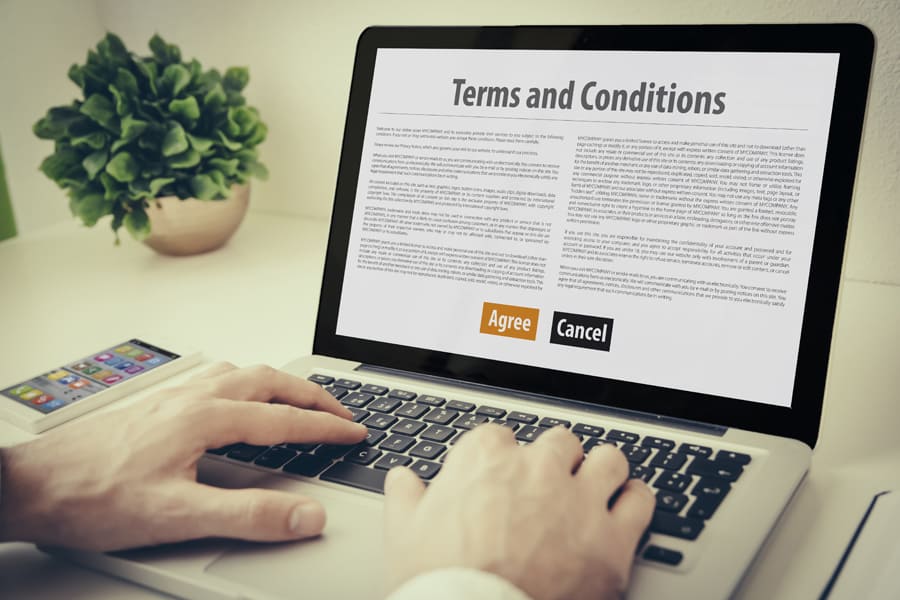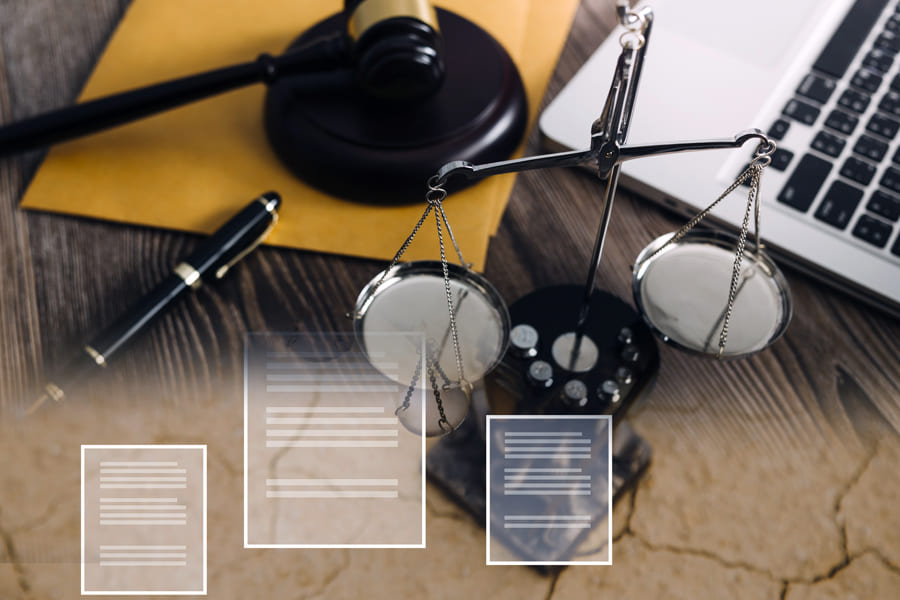If you are selling products online, you will need to produce terms and conditions for ecommerce websites or other online stores. While these documents are not legal requirements, they are useful for your business. With robust terms and conditions in place, you instill a sense of trust in your customers and help to solve any potential issues before they get out of hand.
But how do you write terms and conditions for ecommerce websites? We have produced a guide that can help you do precisely this. Look at the sections below to learn more about what to include.
While not all sections will apply in every situation, this is still a helpful reference point as you draft ecommerce terms and conditions for your online store.

Introduction to terms and conditions
Start with a brief introduction clause for your terms and conditions – perhaps two or three sentences or short paragraphs. This ensures that your users know exactly what they are reading and everything is clear and transparent from the very start.
Here’s what you should cover in your short introduction:
- A sentence welcoming the user to the terms and conditions page.
- A sentence to explain what these terms and conditions are for – for example, “providing a framework of rules that apply to your specific website”.
- A sentence to explain that users are not permitted to use the website or access any of your products and services if they disagree and comply with these terms and conditions.
- Contact information if the user has any questions about the terms and conditions included.
- Extra terms and conditions may be applied to a document – for example, if you ship products or offer services overseas, there may be additional conditions.
The introduction is designed to orient the user so they know what they are reading and what the document is for. You can add more detail later in the document as you work through the sections below.
Scope of terms and conditions
The scope of the terms and conditions sets out the parameters for the document. In other words, it tells the reader which circumstances the terms and conditions will apply.
You will already have covered this briefly in your introduction, but you’ll need to go into more detail in the “Scope” section.
Include the following information:
- Applicable situations – The terms and conditions generally apply whenever a user accesses your website or your products and services.
- The right to modify – The document may be modified in the future – within the bounds of the law – and your business is not obliged to inform your customers of this modification. You may state that you will try to notify your customers, but this is not guaranteed.
- Exclusions – The terms and conditions may exclude or supersede other terms or conditions discussed verbally or in writing. Again, these exclusions must be within the bounds of the law and the regulations that govern your industry.
You need your terms and conditions to be clear and comprehensive, and outlining the scope is a big part of this. As your business grows and evolves, you may need to expand the scope.
Definition of terms used in the document
For optimal clarity, you’ll need to define the terms you will use throughout the document. This also makes the document more concise and easier to read, as you won’t have to define each term every time you use it.
- Key terms – The key terms refer to the phrasing you will use repeatedly to refer to your own business, your website, and your customers within the document. You’ll need to define that “us” and “we” refer to your business name, “website” or “the website” refers to your specific website, and “you” refers to anyone who accesses this website.
You may also want to define more general terms like “product” or “service.” Tell the user that these words refer to all of the products and services that are listed on the site.
- Geographical terms – It may be useful to define the locations you do business in. For example, if you mention “states of operation” in the terms and conditions, this may refer to a list of specific states in the USA – make this clear to your users. You may also let your users know that your area of operations could expand.
- General terms – Give definitions for any terms for any other words that may not be clear to your users. Take “cookies” as an example – don’t assume that your users will automatically know what these are. “Special conditions” will also need a definition – let your users know that this relates to specialized rules attached to specific products and services.
We’ve included a few general examples, but this section is for any terms your users may find confusing. Aim to make it easy for your users to understand your terms and conditions by covering key terms here.
Legal requirements and compliance
Online retailers need to comply with governing laws and regulations in their field. Your terms and conditions do not replace these legal liabilities, and users can still take legal action against you in the event of personal injury or loss caused by a product.

You should outline these legal regulations and how you comply with them in your terms and conditions document:
- Product safety – Consumers have the right to safety and security when they use a product, so you must comply with all product safety regulations.
- Data protection – Customers may provide you with sensitive information during account creation or other user actions. You’ll need to handle this information in a compliant way.
- Consumer rights – Different jurisdictions operate their own consumer rights regulations, and you can reassure your customers that their rights are protected when they shop with you.
- Liability disclaimer – You may want to include a liability disclaimer in the terms and conditions document. This will not free you from your obligations under the law or any other relevant regulations.
Bear in mind that regulatory compliance and legal requirements can change over time. Review this document section periodically, adding further compliance points as they become relevant.
Terms of use
The terms of use are conditions your users must accept when interacting with your website. Including these terms of use in your document is a way to inform users of these various clauses and conditions.
Within these terms of use, you should cover:
- How data and information are collected.
- What types of data and information are collected.
- What will you do with this data and information.
- The website’s use of cookies.
- Prohibited uses of the website – for example, copying images or text.
- Limitations of the website – stating that all information provided is for reference purposes only and acknowledging that there may be mistakes or omissions.
By publishing this document on your website, you receive implied consent from your users whenever they visit the site. This is different from active consent, in which the user must actively indicate that they understand and agree to the terms and conditions.
Privacy policy
In this section, you will provide more detailed information regarding the privacy policy of your ecommerce business. Start with a short statement of one or two sentences that outlines how personal data is treated confidentially and by all regulations and legal requirements.
To provide further information to your users, identify what these regulations are. In the United States, you will be bound by state privacy legislation, like the California Consumer Privacy Act. In the European Union, the General Data Protection Regulation will apply.
You can link to more detailed descriptions of how you collect data, how it is stored, and the circumstances in which it is used. This may be covered in a separate document but should be linked from your terms and conditions page. Give your users information on how they can opt out of marketing communications or emails, too.
Remember that the information you include in your privacy policy – and elsewhere in the terms and conditions document – does not replace your legal obligations. For instance, when you list how personal data may be used, all of these uses must still be regulatory compliant. The document cannot offer legal protection if data is being misused.
Payment terms and conditions
One of the main aspects of your ecommerce store is your payment capability. This is where your customers will purchase your products and services via online payment methods.
To cover this area of your business, a comprehensive terms and conditions document will include a payment clause.
As you create ecommerce terms regarding payment, you may need to have the following clauses:
- How payments can be made – i.e., which forms of payment you accept in your online store;
- Which international currencies are accepted;
- How ongoing subscriptions work – i.e., what happens if payments are missed on a subscription;
- Which security features are used to protect payment gateways and ecommerce pages;
- How customers can use gift vouchers and promotional codes within the online store;
- How customer payment data is protected;
- How customers can get in touch if there is a problem with the payment, or if there are any other related issues.
Depending on the structure of your business, this section may be pretty straightforward, or it may be reasonably complex. For instance, if you sell physical products, digital products, and software-as-a-service subscriptions together, this may result in a more diverse set of payment terms and conditions.
Shipping and delivery policy
If you are selling physical products via your online business, you will need to ship these products to your customers. This is where your delivery terms come in, the conditions that outline delivery expectations for your users.

Even if you are not selling physical products, you may need to explain how services and digital products will be delivered to the consumer.
- Define your delivery areas – i.e., the locations around the world that you ship to.
- Describe the process for products that go missing. You may not be solely responsible for ensuring products arrive complete and on time, as the shipping company or postal service may take some liability.
- Explain the expected service levels – for instance, software-as-a-service products will require minimum system specifications to run correctly. In contrast, other services may only be available at certain times throughout the working day.
- Mention that shipping and delivery terms may change and that your company does not need to provide prior notice.
Shipping and delivery policies are another area you must monitor as your business grows. If you expand into a new service area, there are new shipping and delivery terms that need to be made clear to your customers.
Returns and refund policy
Online stores and ecommerce businesses need a returns and refund policy in place. This policy restates the consumer’s rights and explains how products can be returned.
In your terms and conditions document, include the following:
- The circumstances in which a refund is offered – if products arrive damaged, for example, or if there is a fault.
- The circumstances in which refunds are not provided – if the user changes their mind, for instance.
- The length of the standard warranty or the time the customer has to begin the return process.
- Alternatives to a refund – like store credit, a replacement item, or a gift voucher.
- Methods for returning products – such as using designated couriers specially chosen by your business.
- Liability for return costs, or who will need to pay to send the item back.
Different jurisdictions will have consumer care legislation, and the terms and conditions will not invalidate this. All returns and refund policy clauses must abide by all applicable laws.
Intellectual property rights
When you start your business, create a product, or formulate a service, you have the right to protect your intellectual property. These are any ideas, designs, or unique elements you came up with during the development. No one is allowed to copy this work without your say-so.
Similarly, other people have this same right. You are only permitted to copy anyone else’s work if they permit you, and intellectual property theft is taken very seriously in most places worldwide.
In the intellectual property clause of your terms and conditions, you should reaffirm that all ideas and designs are your work or that you have the right to use this work. Make it clear that no one else is permitted to use this work and that you will protect intellectual property rights and combat theft to the maximum extent permitted by law.
Limitation of liability and indemnification
The terms and conditions agreement is a legal document between you and your customers or other users. As such, you need to be very careful with how the document is worded, and you must ensure that there is a limit of liability clause included.
In the limitation of liability section, you should note that the terms and conditions apply to your company, so no individual board members or employees will bear liability alone. If gross negligence is suspected, or if there is a violation of criminal or civil law, individual team members may still be liable.
If you partner with other organizations, you may wish to include a liability disclaimer in your terms and conditions. For example, you may say that you take no responsibility for the content of any third-party websites reached by external links from your website. These third-party links are outside of your control, and users should exercise caution when they click.

Dispute resolution and governing law
In a dispute, the parties involved must know how this will be resolved. This is outlined in the dispute resolution clause.
In this section of the document, you need to include:
- Who will oversee the dispute? Is there an industrial body that will handle this, or will it fall under the jurisdiction of a judge?
- Where will the revolution take place?
- How long will the resolution take to complete?
- What is the appeal process for a dispute resolution judgment?
A governing law clause is also necessary here. This is the legal framework that will be applied to dispute resolution. In many cases, governing law is – if both parties are located in France, for example, French law will be applied.
In federal systems, or if the dispute is international, it may be more complicated. You may need to identify the legal system that will oversee the dispute. Alternatively, you may include a choice of applicable law clause, which allows parties to select the legal framework that is applied.
Changes to terms and conditions
Over time, you may need to change your terms and conditions. These changes may be internal – due to changes to your company structure or the launch of a new product – or external – caused by a change in the law.
In this document section, you must explain these changes to your users. You may want to notify your users of these changes in advance – in which case, you might say that prior notice will be given if it is possible to do so. There is no legal requirement to offer this advance notice, but you should clarify that these notifications are not guaranteed.
You should also state that the user is bound by the most recent terms and conditions document. So, if users read the terms and conditions when they accessed the site in 2022, they will still be bound by the 2023 terms and conditions even if they have yet to read this new document.
User Agreement
User agreement can be active or implied. When you visit a website, you may not even notice the terms and conditions. Often, these will be found via a link at the very bottom of a page on the website. For general purposes, this is sufficient – the fact that the document exists and is accessible is enough. This is implied consent.
Other user actions may need a higher level of consent. If your users sign up for a specific service, they may need to actively check a box or click a button to show that they have read and understood the document and agree to the terms.
These boxes and buttons may only be visible once the user has scrolled through the entire document to show that the user is at least aware of the whole document’s length. This is active consent.
Termination of agreement
You may not need to include a termination of agreement cause in your online store’s terms and conditions. The terms and conditions document refers to the use of the website and will remain in place for as long as the website is online.
However, when creating comprehensive usage agreements for software, services, or other subscription-based offerings, you may need a termination of agreement clause.
This clause may include the following:
- Information on how to cease the agreement – perhaps by offering prior written consent to terminate the contract;
- Information on minimum service levels by the agreement – ongoing product problems or customer service issues may invalidate the agreement;
- Information on the end user license agreement for mobile apps or computer software – including user actions that may violate the terms and conditions;
- Information on restricted parties – some individuals may be excluded from some service agreements due to criminal and financial records;
- Information on any predetermined timeframes for the agreement, if applicable.
The termination section will include any circumstances in which a contract can come to an end or be invalidated. The specifics of this section will depend on the structure of your business and the industry you operate in.

Terms and conditions for ecommerce websites – getting it right
You don’t need a terms and conditions page on your ecommerce website, but it’s recommended. These are valuable documents that you and your customers can use to outline and understand your relationship. It also offers protection in the event of a dispute. If you provide products and services via online transactions, this document is very useful indeed.
However, it is still a legally binding agreement.
With this in mind, you want to get it right. It is advisable to consult with a professional before you publish your terms and conditions. The legal fees you pay for this service may save you more money further down the line, as there may be something important that you missed.
Frequently asked questions
How to write terms and conditions for ecommerce websites?
Terms and conditions agreements are legal documents, so the writing process should be carefully approached. Follow our framework to draft your document, but you may need professional legal help and guidance before you publish it.
Are terms and conditions legally required for ecommerce websites?
No, you are not legally required to publish terms and conditions. However, they can help to instill trust among your customers and resolve potential legal disputes clearly and transparently.
Are terms and conditions legally binding?
Yes, the information you include in the terms and conditions is legally binding – but only up to a point. All of these terms and conditions must be aligned with laws and regulations in your area.